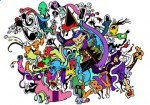LOST ART OF THE ALBUM COVER
posted in: Features • Music News
For consumers, the advantages of the digital music revolution are many: increased accessibility, portability and lessened expenses just to name a few. But forgotten amongst these undeniable advantages is the loss of album artwork, and the social experience that a tangible visual can provide.

Axis: Bold As Love
Despite the age old adage not to judge a book by its cover, album cover art really can speak volumes as to the quality of musical innovation concealed inside. If your album cover boasts the generic image of the secondary band members standing out of focus in the back with lead man up front, or of just a musician with their instrument, then the general assumption might as well be that your music is bland and unoriginal. Yet in today’s world of declining physical music sales and inclining digital music sales, album cover art has more or less become an afterthought.

Sticky Fingers
Believe it or not, there was a time when the art displayed on an album sleeve stood for something. The past 50 years are loaded with culturally relevant album art that just so happened to perfectly represent a band’s or artist’s personality. Jimi Hendrix exploited the psychedelic fad of the 1960’s with his Axis: Bold as Love cover in 1967. The Rolling Stones exhibited the quintessential 70’s rockstar arrogance with Sticky Fingers, expelling their sexual prowess through the historic skinny jeans crotch photograph. The album even came with a built in zipper fly, just so you could feel like you were unzipping a Rolling Stone member’s pants.

Appetite For Destruction
While 80’s pop culture is largely remembered for spandex and keytars, Guns ‘N’ Roses 1987 Appetite For Destruction cover was in stark contrast to the prevailing 80’s pop music tradition of bright colors and artist portraits. Originally designed as a tattoo, the crucified skulls represent Axl, Slash, Duff, Izzy and Adler in their quest for rock ‘n’ roll mayhem. And to think that this cover was the less controversial of the two options! The first displayed a metal avenger monster on the verge of mutilating a robotic rapist.

Nevermind
The 90’s witnessed bipolarity in popular music. Not surprisingly, the grunge scene remained incognito from pop culture until the rise of unsuccessfully elusive rockers Nirvana. When their smash hit Nevermind was released, the indelible photo of a naked baby- Spencer Elden- swimming after money became a sign of the time; innocence chasing greed. Unfortunately, it seems like uninspired artwork among popular music has become the norm ever since.
Think about it. Why put effort into album artwork when it’s only going to be seen as a digital thumbnail on your computer screen or iPod? Plus, the idea of friends gathering to listen to music while exploring CD covers almost seems ridiculous. Still, there are some artists out there putting time and effort into cover artwork even though others have labeled the practice extinct. After all, it doesn’t hurt to put out the most complete musical package possible. Below is a collage of 6 intriguing album covers all created by OurStage’s very own!






